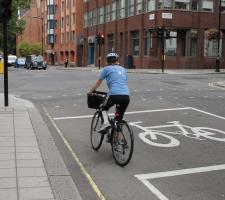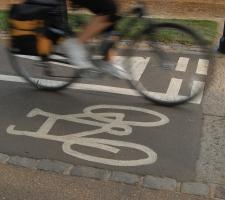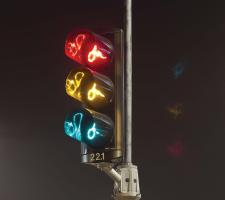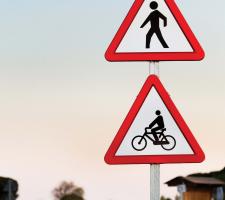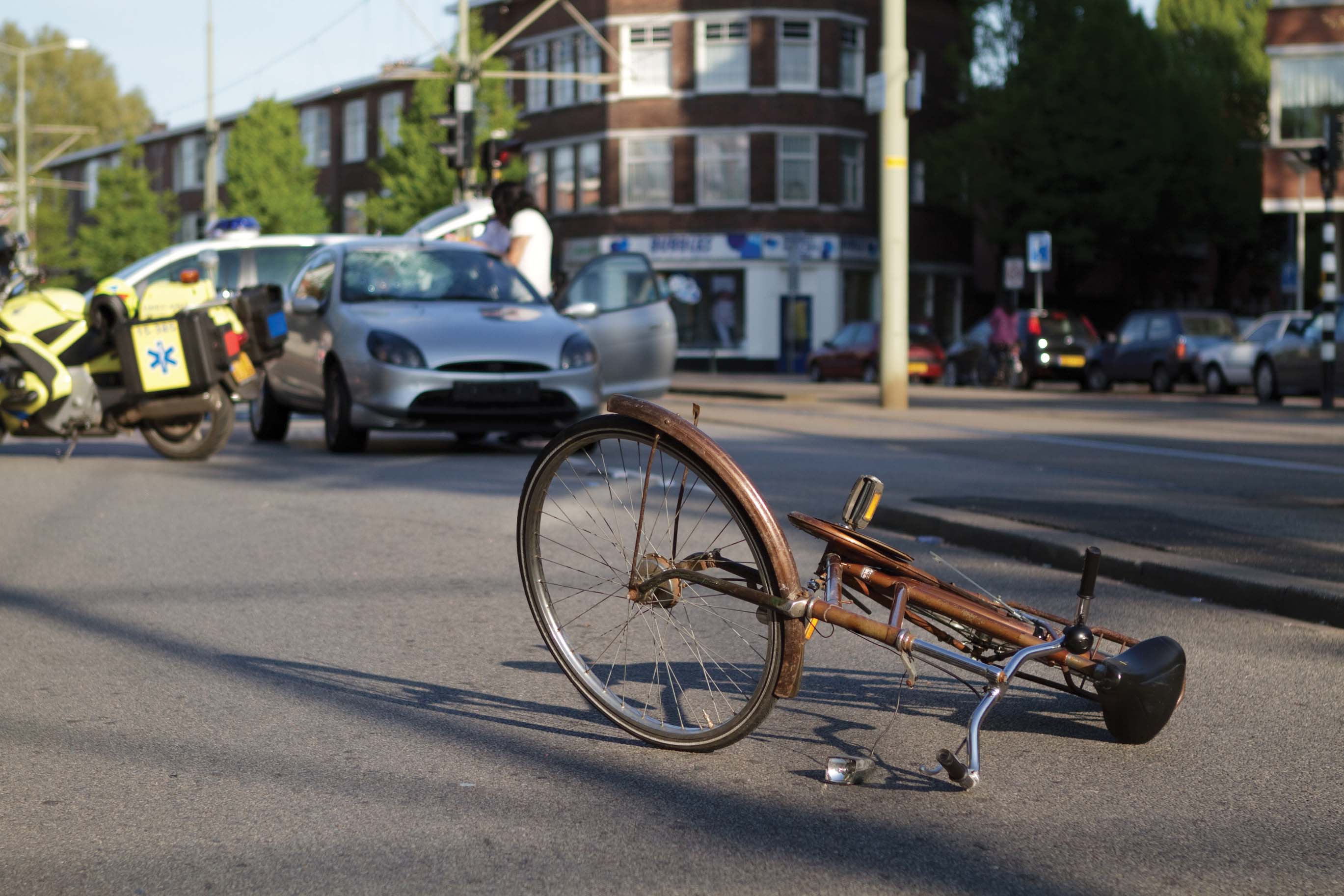
Cyclists are up to three times more likely to be killed on the road than car drivers
A new generation of ITS equipment is helping road authorities get to grips with cycle safety – and not a moment too soon as Colin Sowman discovers.
Cyclists - remember them? Apparently not. At least not according to the7353 OECD 2013 report Cycling, Health and Safety which contains the statement: ‘Cyclists are often forgotten in the design of the road traffic system’. Looking through the statistics that exist (each country appears to compile them differently) it is not difficult to see how such a conclusion could be reached. Statistics from the US-based Alliance for Biking and Walking (ABW) show that across the US cycling account for 1% of journeys in America yet cyclists make up 1.8% of road fatalities. The situation is even worse in the 51 largest cities where cycling is slightly higher (1.1% of journeys) but cyclists account for 3.1% of road fatalities.
Government statistics from the UK show a not dissimilar situation with cyclists accounting for 2% of road journeys but 6.7% of fatalities. Compare that with this statistic: 64% of journeys are undertaken by car, where drivers and occupants account for only 45% of those killed on the road. Taking a 1:1 ratio between the percentages of journeys and that of road deaths as ‘neutral’, the statistics indicate that the risk of UK cyclists dying on the road is 3.35 times higher than the average or 2.8 times higher if you cycle in the US. And yet there are millions, if not billions of dollars, pounds, Euros, Yen... being pumped into the safety of cars and bigger motor vehicles, but on cycle safety the spend is miniscule. The ABW calculates the spend for both cycling and walking combined is only 1.6% of the federal transportation budget even though those modes account for 12% of all trips.
With the average bicycle trip in the UK increasing from 3.7km (2.3mi) in 95/97 to 5.1km (3.2mi) in 2012), cycling benefits both drivers and passengers using other modes (less congestion and overcrowding) and, accidents aside, the general health of cyclists. A 2009 paper by Rabl and Nazelle calculated the average health benefit of switching from a car to a bicycle in Europe’s largest cities to be €1,343 per year. The negative health impacts, including fatalities, averaged €72 per year.
The OECD says cycling can be increased without a corresponding rise in accidents and fatalities if attention is paid to good policy design and that accident rates can be reduced by increasing cycling safety measures. A good example comes from the Institute for Road Safety in the Netherlands which indicates that cycling accounts for a quarter of all journeys and only a marginally higher proportion (28%) of road fatalities. Half the journeys in Amsterdam are done by bicycle, and OECD figures show a 32% modal share for cycling on short journeys in Beijing and 31% in both Copenhagen and Patna, India.
Contrary to the general trend of reducing road deaths, in many countries cyclists are facing an increased risk of dying on the roads. This increased risk that cyclists face calls into question the rationale and wisdom in implementing policies promoting cycling over cars and other statistically safer forms of transport. After reviewing the evidence, the OECD concluded that ‘the estimated health benefits of cycling are several orders of magnitude greater than the dis-benefits.’
There are signs of authorities taking this thinking onboard as, for instance, California has legislated to ensure provisions are made to detect cyclists when junctions are built or refurbished. This move is particularly important as in Europe around a quarter of cycling fatalities occur in the urban environment and the proportion is even higher in the US and Korea. The potential for cyclist fatalities also increases when traffic speeds go above 40km/h and during the hours of darkness.
Events in London last year bought the cycling debate to the fore when six cyclists were killed over a two-week period in November 2013, bringing the total of cyclists killed on London’s streets to 14 (to equal 2012’s figure). Heavy goods vehicles were involved in nine of the 14 fatalities in London.
London has experienced something of a cycling boom with the distance travelled by cyclists up by more than 60% since 1997.1466 Transport for London (TfL) says bicycles make up 25% of traffic in the morning rush hour with some 90,000 cycle journeys on the average weekday, although overall cycling still only accounts for around 2% of journeys. TfL’s figures for 2012 show that cyclists accounted for just over 10% of road deaths (14 out of 134) and 23% of serious injuries.
Under the leadership of London’s pro-cycling Mayor Boris Johnson, TfL has implemented a number of schemes to improve cycle safety including road layout modifications and ‘cycle superhighways’. These moves have met with some success as 2012 cycling fatalities dropped to 14 from 16 in 2011, but three of the cyclists killed in November 2013 were riding on cycling superhighways. At an inquest the Coroner called the unbordered blue strips of paint that denote the cycle superhighways ‘confusing’ and said ‘it lulled cyclists into a false sense of security’.
That being the case the cycle superhighways fail two of the OECD’s (subsequent) recommendations: that road design should be easily recognisable and predictable for all traffic participants and that bicycles should be physically separated from other traffic unless motorised speeds are ‘quite low’. Mayor Johnson says he is planning further cycle superhighways but cannot guarantee to segregate vehicles and cyclists on all routes.
London’s experience reinforces OECD findings that the most likely cause of fatalities among cyclists is a collision with a car, while pointing out that collisions with heavy vehicles are likely to have a more serious outcome. For his part Mayor Johnson wants trucks fitted with additional equipment to cover any blind spots in the driver’s field of vision and side guards to prevent cyclists being dragged beneath a truck in the event of an accident. Although he does not have the power to ban lorries without safety equipment he told the4967 BBC he plans to use the powers he does have “to levy a hefty charge on lorries without such equipment.”
Also towards the end of November 2013, London’s Metropolitan Police launched Operation Safeway, deploying 2,500 officers at 170 junctions throughout London resulting in around 13,400 fines being issued. Cyclist received 4,269 fines - almost 1,600 of which were for riding without lights at night, around 1,000 for cycling on a footway and 1,200 for contravening traffic signals. Almost as many drivers (1,113) contravened traffic signals and more than 2,500 were caught using a mobile phone with a similar number not wearing seatbelts. A further 87 were fined for driving without due care and attention while 42 drivers were caught driving in a cycle lane.
Most of the drivers contravening traffic signals were penalised for passing the Advanced Stop Lines designed to allows cyclists space in front of traffic queues at signalled junctions. This separation aims to ensure drivers see cyclists and to provide cyclists with additional time to clear the junction in order to avoid potential collisions with turning vehicles.
Until recently cycle safety had not figured large in ITS systems, possibly due to the difficulty in detecting, identifying and separating cyclists from other road users. Now, however, in answer to demands from the authorities in California and elsewhere, a host of technology has recently been introduced in this area. Some of these products are designed to enable authorities to identify cyclists in order to treat them as a distinct traffic stream and then arrange signalling and road layouts to improve cycle safety while others are warning systems for drivers - both onboard the vehicle and roadside.
Video detection specialist73 Iteris is a good example and is launching its Vantage SmartCycle software to detect bicycles at a junction. The system detects both cycles and vehicles using a single camera facing a dedicated approach and cycle-specific virtual detection zones can be placed anywhere within the approaching traffic lanes.
When a bicycle is detected the system triggers the green light sequence and allows additional time for the cyclists to clear the intersection. When no cyclists are present, the green light phase can revert to the shorter period if required.
According to Iteris president and CEO Abbas Mohaddes, “SmartCycle provides traffic engineers with a cost-effective way to bring their traffic management systems into compliance with new regulations that require bicycle detection.”
Taking a slightly different approach is6778 FLIR’s latest ThermiCam traffic sensor which can distinguish bicycles from other vehicles both approaching and at un-segregated stop lines.
Launched at the6456 ITS World Congress in Tokyo, the ThermiCam uses thermal (rather than visible) video images to detect the heat emitted from bikes and other vehicles to differentiate between the two. Having detected cyclists, the sensor will transmit that information either directly to the sequencing/timing system or via IP to the traffic light controller.
ThermiCam is able to handle up to 16 virtual vehicle detection zones and four virtual bike detection regions. By using thermal imaging FLIR says the detection accuracy remains consistent in all lighting and weather conditions to provide traffic managers with uninterrupted detection of both motorists and cyclists.
US-based manufacturer7435 Reno A&E says it has optimised bike detection through the use of a parallelogram loop design and special algorithms to detect cyclists. Models 1100-B and 1101-B are built for the 3879 Caltrans 332 style cabinets while the 1200-B and 1201-B suit NEMA-style cabinets. The 00 series works with existing loops while the 01 operates with a dedicated parallelogram loop designed for more precise and accurate bicycle detection. While they still detect outputs for all vehicles, the 01 series sends the controller a separate and distinct signal for a bicycle which can be timed to suit bicycles and provide extensions for controllers without dedicated bicycle timing parameters.
Across in the UK, Clearview has supplied TfL with a cycle detection function using magnetometers in conjunction with split cycle offset optimisation (SCOOT). Group product manager Graham Muspratt says: “Our magnetometers can be installed without having to close whole roads – it can be done lane by lane in just 15 minutes. They were tested against loops and side-fired radar before being selected. Above-ground radar proved very good for stop-line detection but still required power cabling, so the capital savings weren’t as great as might be expected.
“TfL is installing low-level signals and implementing cyclist-friendly signal timing regimes. We’re looking at using the same wireless protocol but with in-ground radar which sits in a similarly sized core-drilled stud. There’s a need to detect both the presence and absence of cyclists where new signal phasing is implemented but if there are no cyclists it makes no sense to extend timings as intersection efficiency will be reduced. Upward-facing radar was chosen because more and more bikes have less metal content and where the separation between a cycle and live lanes may only be a white line you need its accuracy.”
Radar detection and monitoring specialists148 Wavetronix configured its SmartSensor Matrix to provide the authority in Tustin, California with an ‘in-the-box’ detection scheme to enable cyclists to clear the intersection before the light changes. SmartSensor Matrix generates 16 separate radar beams to detect bicycles in user-defined zones anywhere in its 90°/42m (140ft) field of view enabling bicycles to be treated like any other vehicle when it comes to activating signals.
Mobile Visual Information Systems (MVIS) thinks it has the answer for authorities looking to launch a cycling safety and awareness campaign. It is championing the potential of temporary variable message signs (VMS) which can be rapidly deployed to accident hot spots, warning cyclists and motorists of the need for extra vigilance.
Steve Young, operations director of MVIS says: “Cycling is an increasingly popular mode of transport so the issue of cyclist safety will not go away.”
Another recently introduced system is Cycle Alert which uses radio frequency identification (RFID) with tags attached to the bicycle or the cyclist’s helmet and sensors fitted around motor vehicles with an in-cab unit. The system alerts drivers if an instrumented bicycle or user is within two metres of their vehicle with an audible ‘cyclist’ warning and a flashing light to indicate the position of the cyclist(s) around the vehicle. When the bicycle is moving, the unit regularly transmits its presence but transmissions stop once the bicycle is stationary for a period.
Cycle Alert’s co-founder and system innovator Peter Le Masurier developed the system after listening to an interview with a truck driver who have been involved with an accident with a cyclist. “I recognised then that not one, but two families are left devastated by such incidents,” he says, adding: “Everybody needs to take responsibility for their own safety on the road. Cycle Alert empowers cyclists to make themselves more obvious to HGV drivers.”
Working with operator TransdevUnibus, the council in the UK university city of York has fitted Cycle Alert readers to its inner city buses while the tags are available to students at the Union shop and via a website for other cyclists in the city.
A non-interactive approach is that of Navevo’s ProNav HGV Cyclist Alert, which the company says is the first satellite navigation system for trucks that notifies drivers when they are entering a high HGV/cyclist convergence area. Developed in association with TfL, the software provides commercial vehicle drivers with an audible and visual alert as they approach junctions or sections of roads which regularly have high volumes of HGVs and cyclists. A warning symbol is displayed on the navigation system’s mapping that projects a 100m diameter ‘warning zone’ around each convergence area. Truck drivers entering these zones get a short audible warning to remind them of the increased potential for cycle traffic and allowing plenty of time to check for cyclists.
An alert at every junction was considered to be counterproductive so an initial 100 high HGV/cyclist convergence areas have been identified across the city using data from the Department for Transport’s HGV and pedal cycle flow data for London’s road network. Navevo plans to work with other local authorities to increase coverage and will provide free updates when new data becomes available.
While the severity of collisions between large vehicles and cyclists is likely to be high, the probability is much lower than that of colliding with a car - a fact that has not escaped car manufacturer609 Volvo. It has developed a Cyclist Detection system which ‘recognises’ a cyclist ahead of the vehicle and will automatically apply the brakes to prevent a collision.
Volvo’s technical specialist Erik Coelingh says: “The systems uses a camera and radar combination mounted at the front of the vehicle. The camera recognises the shape of a cyclist while the radar can measure the distance to the cyclist. Successive measurements are used to determine the cyclist’s trajectory and closing speed and enable the system to determine whether or not a collision is approaching.”
Currently the Cyclist Detection camera has an angle of view of just over 40° while radar’s field of view is slightly narrower at +/- 30° and as configured the system is not designed to prevent a collision with cyclists when turning at a junction. “We have prioritised accidents where the cyclist is in front of the vehicle,” Coelingh says.
Using two sensors with different sensing principles reduces the risk of unnecessary warnings and Brake activations as does programming the camera to only recognise vehicles, pedestrians or cyclists. Should an unrecognised item end up in the vehicle’s path, the City Safety system will apply the brakes to prevent a collision – albeit that is not the system’s primary function.
“We have performed a lot of real-world driving, with different drivers in different traffic environments to ensure that the risk of false braking is sufficiently low,” says Coelingh, adding that the driver can deactivate the collision warning but not the automatic emergency braking.
So after what many may feel is a slow start, ITS technology is now more than able to help authorities around the world improve cycle safety.
Cycle helmets
The7120 Insurance Institute for Highway Safety in the US says the most common cause of death for cyclists involved in a collision was head injuries and that helmet use has been estimated to reduce the risk of head injury by 85%. It also points out that cyclists known to be wearing a helmet at the time of their accident made up only 15% of fatalities while those recorded as not wearing a helmet account for 67% of fatalities.
Eco Counter
The lack of data on the number of people cycling is a concern for the OECD and one that a company called6713 Eco-counter believes it can solve with its Eco Totem. The 2.1m-high Eco Totem has an electronic counter that uses sensors in the road to count cycles in both directions and display daily and year-to-date totals. Users include UCLA (to demonstrate the need for new bike lanes on campus and on city streets leading to campus) and Seattle Department of Transport to gather data on bike traffic across Fremont Bridge, one of the city’s busiest cycle commuter routes.
Cyclists - remember them? Apparently not. At least not according to the
Government statistics from the UK show a not dissimilar situation with cyclists accounting for 2% of road journeys but 6.7% of fatalities. Compare that with this statistic: 64% of journeys are undertaken by car, where drivers and occupants account for only 45% of those killed on the road. Taking a 1:1 ratio between the percentages of journeys and that of road deaths as ‘neutral’, the statistics indicate that the risk of UK cyclists dying on the road is 3.35 times higher than the average or 2.8 times higher if you cycle in the US. And yet there are millions, if not billions of dollars, pounds, Euros, Yen... being pumped into the safety of cars and bigger motor vehicles, but on cycle safety the spend is miniscule. The ABW calculates the spend for both cycling and walking combined is only 1.6% of the federal transportation budget even though those modes account for 12% of all trips.
With the average bicycle trip in the UK increasing from 3.7km (2.3mi) in 95/97 to 5.1km (3.2mi) in 2012), cycling benefits both drivers and passengers using other modes (less congestion and overcrowding) and, accidents aside, the general health of cyclists. A 2009 paper by Rabl and Nazelle calculated the average health benefit of switching from a car to a bicycle in Europe’s largest cities to be €1,343 per year. The negative health impacts, including fatalities, averaged €72 per year.
The OECD says cycling can be increased without a corresponding rise in accidents and fatalities if attention is paid to good policy design and that accident rates can be reduced by increasing cycling safety measures. A good example comes from the Institute for Road Safety in the Netherlands which indicates that cycling accounts for a quarter of all journeys and only a marginally higher proportion (28%) of road fatalities. Half the journeys in Amsterdam are done by bicycle, and OECD figures show a 32% modal share for cycling on short journeys in Beijing and 31% in both Copenhagen and Patna, India.
Contrary to the general trend of reducing road deaths, in many countries cyclists are facing an increased risk of dying on the roads. This increased risk that cyclists face calls into question the rationale and wisdom in implementing policies promoting cycling over cars and other statistically safer forms of transport. After reviewing the evidence, the OECD concluded that ‘the estimated health benefits of cycling are several orders of magnitude greater than the dis-benefits.’
There are signs of authorities taking this thinking onboard as, for instance, California has legislated to ensure provisions are made to detect cyclists when junctions are built or refurbished. This move is particularly important as in Europe around a quarter of cycling fatalities occur in the urban environment and the proportion is even higher in the US and Korea. The potential for cyclist fatalities also increases when traffic speeds go above 40km/h and during the hours of darkness.
Events in London last year bought the cycling debate to the fore when six cyclists were killed over a two-week period in November 2013, bringing the total of cyclists killed on London’s streets to 14 (to equal 2012’s figure). Heavy goods vehicles were involved in nine of the 14 fatalities in London.
London has experienced something of a cycling boom with the distance travelled by cyclists up by more than 60% since 1997.
Under the leadership of London’s pro-cycling Mayor Boris Johnson, TfL has implemented a number of schemes to improve cycle safety including road layout modifications and ‘cycle superhighways’. These moves have met with some success as 2012 cycling fatalities dropped to 14 from 16 in 2011, but three of the cyclists killed in November 2013 were riding on cycling superhighways. At an inquest the Coroner called the unbordered blue strips of paint that denote the cycle superhighways ‘confusing’ and said ‘it lulled cyclists into a false sense of security’.
That being the case the cycle superhighways fail two of the OECD’s (subsequent) recommendations: that road design should be easily recognisable and predictable for all traffic participants and that bicycles should be physically separated from other traffic unless motorised speeds are ‘quite low’. Mayor Johnson says he is planning further cycle superhighways but cannot guarantee to segregate vehicles and cyclists on all routes.
London’s experience reinforces OECD findings that the most likely cause of fatalities among cyclists is a collision with a car, while pointing out that collisions with heavy vehicles are likely to have a more serious outcome. For his part Mayor Johnson wants trucks fitted with additional equipment to cover any blind spots in the driver’s field of vision and side guards to prevent cyclists being dragged beneath a truck in the event of an accident. Although he does not have the power to ban lorries without safety equipment he told the
Also towards the end of November 2013, London’s Metropolitan Police launched Operation Safeway, deploying 2,500 officers at 170 junctions throughout London resulting in around 13,400 fines being issued. Cyclist received 4,269 fines - almost 1,600 of which were for riding without lights at night, around 1,000 for cycling on a footway and 1,200 for contravening traffic signals. Almost as many drivers (1,113) contravened traffic signals and more than 2,500 were caught using a mobile phone with a similar number not wearing seatbelts. A further 87 were fined for driving without due care and attention while 42 drivers were caught driving in a cycle lane.
Most of the drivers contravening traffic signals were penalised for passing the Advanced Stop Lines designed to allows cyclists space in front of traffic queues at signalled junctions. This separation aims to ensure drivers see cyclists and to provide cyclists with additional time to clear the junction in order to avoid potential collisions with turning vehicles.
Until recently cycle safety had not figured large in ITS systems, possibly due to the difficulty in detecting, identifying and separating cyclists from other road users. Now, however, in answer to demands from the authorities in California and elsewhere, a host of technology has recently been introduced in this area. Some of these products are designed to enable authorities to identify cyclists in order to treat them as a distinct traffic stream and then arrange signalling and road layouts to improve cycle safety while others are warning systems for drivers - both onboard the vehicle and roadside.
Video detection specialist
When a bicycle is detected the system triggers the green light sequence and allows additional time for the cyclists to clear the intersection. When no cyclists are present, the green light phase can revert to the shorter period if required.
According to Iteris president and CEO Abbas Mohaddes, “SmartCycle provides traffic engineers with a cost-effective way to bring their traffic management systems into compliance with new regulations that require bicycle detection.”
Taking a slightly different approach is
Launched at the
ThermiCam is able to handle up to 16 virtual vehicle detection zones and four virtual bike detection regions. By using thermal imaging FLIR says the detection accuracy remains consistent in all lighting and weather conditions to provide traffic managers with uninterrupted detection of both motorists and cyclists.
US-based manufacturer
Across in the UK, Clearview has supplied TfL with a cycle detection function using magnetometers in conjunction with split cycle offset optimisation (SCOOT). Group product manager Graham Muspratt says: “Our magnetometers can be installed without having to close whole roads – it can be done lane by lane in just 15 minutes. They were tested against loops and side-fired radar before being selected. Above-ground radar proved very good for stop-line detection but still required power cabling, so the capital savings weren’t as great as might be expected.
“TfL is installing low-level signals and implementing cyclist-friendly signal timing regimes. We’re looking at using the same wireless protocol but with in-ground radar which sits in a similarly sized core-drilled stud. There’s a need to detect both the presence and absence of cyclists where new signal phasing is implemented but if there are no cyclists it makes no sense to extend timings as intersection efficiency will be reduced. Upward-facing radar was chosen because more and more bikes have less metal content and where the separation between a cycle and live lanes may only be a white line you need its accuracy.”
Radar detection and monitoring specialists
Mobile Visual Information Systems (MVIS) thinks it has the answer for authorities looking to launch a cycling safety and awareness campaign. It is championing the potential of temporary variable message signs (VMS) which can be rapidly deployed to accident hot spots, warning cyclists and motorists of the need for extra vigilance.
Steve Young, operations director of MVIS says: “Cycling is an increasingly popular mode of transport so the issue of cyclist safety will not go away.”
Another recently introduced system is Cycle Alert which uses radio frequency identification (RFID) with tags attached to the bicycle or the cyclist’s helmet and sensors fitted around motor vehicles with an in-cab unit. The system alerts drivers if an instrumented bicycle or user is within two metres of their vehicle with an audible ‘cyclist’ warning and a flashing light to indicate the position of the cyclist(s) around the vehicle. When the bicycle is moving, the unit regularly transmits its presence but transmissions stop once the bicycle is stationary for a period.
Cycle Alert’s co-founder and system innovator Peter Le Masurier developed the system after listening to an interview with a truck driver who have been involved with an accident with a cyclist. “I recognised then that not one, but two families are left devastated by such incidents,” he says, adding: “Everybody needs to take responsibility for their own safety on the road. Cycle Alert empowers cyclists to make themselves more obvious to HGV drivers.”
Working with operator TransdevUnibus, the council in the UK university city of York has fitted Cycle Alert readers to its inner city buses while the tags are available to students at the Union shop and via a website for other cyclists in the city.
A non-interactive approach is that of Navevo’s ProNav HGV Cyclist Alert, which the company says is the first satellite navigation system for trucks that notifies drivers when they are entering a high HGV/cyclist convergence area. Developed in association with TfL, the software provides commercial vehicle drivers with an audible and visual alert as they approach junctions or sections of roads which regularly have high volumes of HGVs and cyclists. A warning symbol is displayed on the navigation system’s mapping that projects a 100m diameter ‘warning zone’ around each convergence area. Truck drivers entering these zones get a short audible warning to remind them of the increased potential for cycle traffic and allowing plenty of time to check for cyclists.
An alert at every junction was considered to be counterproductive so an initial 100 high HGV/cyclist convergence areas have been identified across the city using data from the Department for Transport’s HGV and pedal cycle flow data for London’s road network. Navevo plans to work with other local authorities to increase coverage and will provide free updates when new data becomes available.
While the severity of collisions between large vehicles and cyclists is likely to be high, the probability is much lower than that of colliding with a car - a fact that has not escaped car manufacturer
Volvo’s technical specialist Erik Coelingh says: “The systems uses a camera and radar combination mounted at the front of the vehicle. The camera recognises the shape of a cyclist while the radar can measure the distance to the cyclist. Successive measurements are used to determine the cyclist’s trajectory and closing speed and enable the system to determine whether or not a collision is approaching.”
Currently the Cyclist Detection camera has an angle of view of just over 40° while radar’s field of view is slightly narrower at +/- 30° and as configured the system is not designed to prevent a collision with cyclists when turning at a junction. “We have prioritised accidents where the cyclist is in front of the vehicle,” Coelingh says.
Using two sensors with different sensing principles reduces the risk of unnecessary warnings and Brake activations as does programming the camera to only recognise vehicles, pedestrians or cyclists. Should an unrecognised item end up in the vehicle’s path, the City Safety system will apply the brakes to prevent a collision – albeit that is not the system’s primary function.
“We have performed a lot of real-world driving, with different drivers in different traffic environments to ensure that the risk of false braking is sufficiently low,” says Coelingh, adding that the driver can deactivate the collision warning but not the automatic emergency braking.
So after what many may feel is a slow start, ITS technology is now more than able to help authorities around the world improve cycle safety.
Cycle helmets
The
Eco Counter
The lack of data on the number of people cycling is a concern for the OECD and one that a company called



